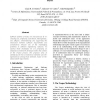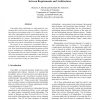ICSE
2003
IEEE-ACM
14 years 11 months ago
2003
IEEE-ACM
A good software architecture is becoming recognized as a major factor for successful products. There has been much research on the technical aspects of software architecture and i...
ICSE
2003
IEEE-ACM
14 years 11 months ago
2003
IEEE-ACM
Software systems of today are characterized by increasing size, complexity, distribution, heterogeneity, and lifespan. Understanding and supporting the interaction between softwar...
ICSE
2003
IEEE-ACM
14 years 11 months ago
2003
IEEE-ACM
Traceability helps stakeholders to understand the relationships that exist between software artifacts created during a software development project. For example, the evolution of ...
ICSE
2003
IEEE-ACM
14 years 11 months ago
2003
IEEE-ACM
Requirements Engineering (RE) deals with the early phases of software engineering namely requirement elicitation, modeling, specification and validation. Architecture of a softwar...
ICSE
2003
IEEE-ACM
14 years 11 months ago
2003
IEEE-ACM
Making architectural decisions based on requirements, analyzing cost-benefit trade-offs, and keeping design options open is a difficult task. Existing work on classification of ar...
ICSE
2003
IEEE-ACM
14 years 11 months ago
2003
IEEE-ACM
This position paper suggests an approach for building software systems using patterns, right from business architecture to software architecture. Further, the approach incorporate...
ICSE
2003
IEEE-ACM
14 years 11 months ago
2003
IEEE-ACM
Requirements engineering and software architecting are two key activities in software life cycle. Researchers have paid much attention to mapping and transformation from requireme...
ICSE
2003
IEEE-ACM
14 years 11 months ago
2003
IEEE-ACM
Ideally, a software project commences with requirements gathering and specification, reaches its major milestone with system implementation and delivery, and then continues, possi...
ICSE
2003
IEEE-ACM
14 years 11 months ago
2003
IEEE-ACM
This paper reports the results of exploratory research to develop a pilot pattern language for systems engineers at BAE SYSTEMS. The pattern language was designed to encapsulate k...
ICSE
2003
IEEE-ACM
14 years 11 months ago
2003
IEEE-ACM
User requirements for telecommunication systems are difficult to understand because they are obscured by a long history of ad hoc feature development and technological limitations...




